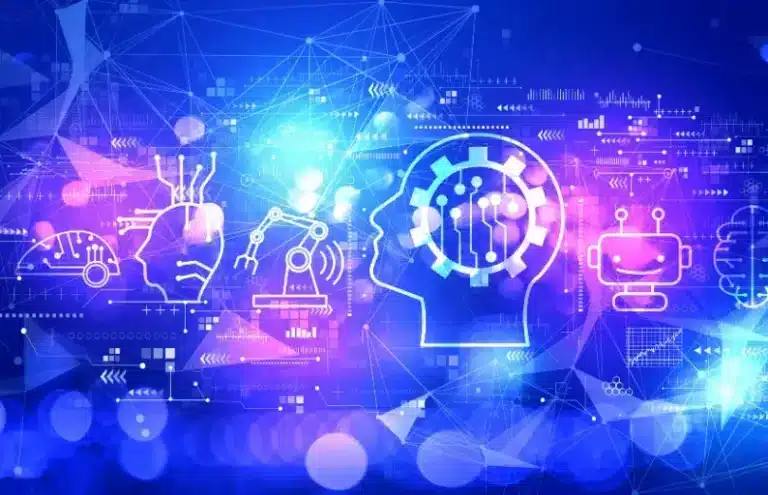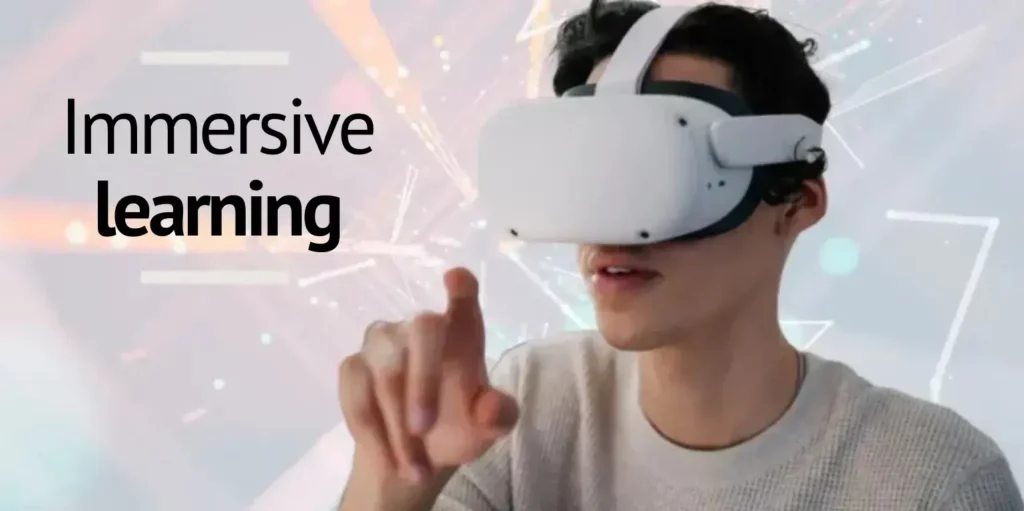Immersive learning is transforming how students and employees acquire new skills and knowledge. It is an approach that combines cutting-edge technologies such as virtual reality (VR), augmented reality education (AR) and immersive virtual environments to create tailored and memorable learning experiences.
This type of learning involves replicating or enhancing real-world experiences within a virtual context, promoting practical understanding and information retention.
Unlike traditional methodologies, immersive learning is not limited to the mere transmission of information but invites users to actively interact with their environment. As a result, it increases motivation and creates a meaningful experience that reinforces the skills and knowledge acquired.
In this article we will explore why this methodology is so effective and how it is applied both in the classroom and, especially, in internal and corporate training.
What is immersive learning?

Immersive learning is an educational and training methodology that uses advanced technologies to immerse participants in interactive learning environments and realistic environments.
It is a type of learning that allows users to actively participate in experiences that mimic or enhance real-world situations, promoting practical understanding, knowledge retention and the development of specific skills.
The key to immersive learning lies in its ability to engage multiple senses at once, creating an environment where participants can interact with the content in a meaningful way. These experiences are often supported by technological tools such as virtual reality (VR), augmented reality (AR) and immersive virtual environments.
With immersive learning, for example, a medical student could practice surgical procedures in a virtual environment that replicates the conditions of an operating room, allowing them to gain confidence and experience without risk to patients.
This approach also incorporates elements of interactivity and narrative to make learning more engaging and effective. In this way, far from being a mere passive recipient of information, the learner makes decisions and actively participates in the experience, fostering greater engagement and motivation.
Moreover, the immediate feedback offered by these platforms allows users to learn from their mistakes and improve their performance in real time.
It is not for nothing that this is one of the latest trends in e-learning. Immersive learning is not only transforming how students acquire knowledge in the classroom, but also how companies train their employees. In the corporate environment, this methodology is used to train teams in soft and technical skills, simulating complex or high-risk work scenarios such as security protocols, conflict resolution or crisis management.
In short, immersive learning combines technology and pedagogy to offer an educational experience that transcends traditional methods. Its ability to create realistic and highly interactive environments makes it a powerful tool for education and training, opening up new possibilities in both academic and business environments.
Rationale and benefits of immersive learning

Immersive learning is an educational and training methodology that combines advanced technologies with innovative psychological and pedagogical principles designed to maximise knowledge retention, foster hands-on and motivating learning and develop essential skills in safe and controlled contexts.
This approach combines advanced technologies and innovative pedagogical strategies to transform the way people acquire knowledge and skills. Through immersive training, people have interactive and emotional experiences that help them retain information.
One of the pillars of immersive learning is the principle of ‘learning by doing’, which involves immersing participants in virtual scenarios that replicate real-world environments, allowing them to practice skills and solve problems in a safe and controlled environment free from the risks of doing so in the real world.
In addition, immersive learning optimises knowledge retention by engaging multiple senses and stimulating the brain in ways that traditional methods cannot match.
Numerous research has shown that participants in immersive experiences tend to remember more information and for longer periods of time, as learning is linked to meaningful and emotional experiences.
For example, a study published in December 2023 by the European Platform for School Education, which analysed the impact of virtual reality in training on the impact of STEM students, concluded that immersive technologies can improve the understanding and retention of complex concepts.
Another crucial aspect of immersive learning is interactivity. Immersive environments often respond in real time to users’ actions, creating a constant feedback loop that encourages active participation. This dynamic increases the motivation of learners, who become more deeply involved in the learning process.
Immersive learning also excels in allowing safe simulations of complex or high-risk situations, i.e. practising skills in a safe environment, avoiding the risk of doing so in ‘real life’. This is particularly useful in sectors such as medicine, where mistakes can have serious consequences, or in industry, where the operation of heavy machinery requires specific skills. In this way, participants prepare themselves to face real challenges by eliminating the risk of making mistakes, without exposing themselves to real dangers and away from the stress of real-life practice.
Thanks to the integration with LMS platforms, immersive learning also adapts to the specific needs of each participant, designing personalised experiences aligned with individual and organisational objectives. In this way, learners can enhance the development of technical skills, such as team management or procedural execution, as well as soft skills such as leadership, conflict resolution and effective communication. For example, a negotiation simulation can teach persuasion techniques while providing immediate feedback on performance.
Finally, immersive training fosters a culture of innovation by encouraging continuous learning and adaptability, especially in highly competitive environments. This is crucial in organisations that need to remain agile in the face of rapid and constant change in their markets.
In short, immersive learning effectively combines theory and practice, transforming education and training. Its ability to provide highly interactive and personalised experiences makes it a powerful tool for preparing individuals and organisations for the challenges of the future.
The components of immersive learning

- An immersive virtual learning environment that replicates real or fictional scenarios to provide a safe and controlled environment.
- Narrative, which provides context and relevance to learning by incorporating an immersive virtual learning environment that guides the experience and helps participants connect emotionally with the content, increasing their motivation and learning retention.
- Interactivity with the user, who must make decisions that mark a certain development of the experience, encouraging active learning.
- El feedback inmediato, que permite a los participantes corregir errores en tiempo real y entender cómo sus acciones y decisiones influyen en los resultados. Además, en ambientes corporativos esta retroalimentación es esencial para refinar habilidades específicas, como pueden ser la negociación o la resolución de conflictos.
The main technologies for immersive learning

The implementation of immersive learning relies on advanced technologies to create interactive experiences. These tools include virtual reality (VR), augmented reality education (AR) and haptic devices, as well as learning management platforms (LMS) that integrate these technologies.
- Virtual reality (VR) is one of the most widely used in immersive learning, as it allows users to fully immerse themselves in interactive three-dimensional environments. This is ideal for training where safety or repetition is critical, such as the aviation industry or medical training.
- Augmented reality (AR), on the other hand, complements the real world with overlaid virtual elements, enriching the learning context and enabling a simultaneous understanding of the real environment and virtual instructions. A practical use case is technical training in industrial maintenance, where workers can visualise diagrams and guides superimposed directly on the machines they are learning to operate.
- Haptic devices, such as haptic gloves or tactile feedback suits, add an additional layer of realism to immersive learning by allowing users to ‘feel’ interactions in the virtual environment. This applies, for example, to learning about a particular surgery, where haptic gloves can simulate the resistance and texture of human tissues.
- Learning management platforms or e-learning platforms also play a crucial role in integrating these technologies and managing educational resources. Such AR tools allow the design and customisation of courses that include immersive elements, facilitate the monitoring of participants' progress and generate reports that allow the effectiveness of learning to be evaluated.
- Finally, simulators and virtual environments allow users to practice specific tasks in a controlled environment, offering practical experiences that prepare for real situations.
The combination of these new technologies with modern pedagogical methodologies such as X-learning and experiential learning technologies is redefining the standards of learning in both educational and corporate environments. As these AR tools continue to evolve, their impact on immersive training promises to be even more significant in the coming years.
Drawbacks and challenges of immersive learning
However, while immersive learning is revolutionising training in different sectors, it also faces certain drawbacks and challenges that need to be considered when implementing this methodology. These challenges, both technical and logistical, can limit its adoption and effectiveness if not properly addressed.
One of the main drawbacks is the high initial cost associated with the technologies needed to create immersive experiences. Equipment such as virtual reality (VR) goggles, haptic devices and advanced computing systems require a significant investment that may be beyond the reach of schools, businesses and organisations with tight budgets. In addition, the maintenance of this technology and the constant upgrading to keep up to date also represent recurring costs.
The technical learning curve is also a major challenge for participants and trainers, who need time to adapt to new VR tools and virtual environments. This can delay the effective implementation of immersive learning and require additional resources for initial training.
Another drawback is the dependence on advanced technological infrastructure such as high-speed Internet connections, powerful computers and adequate space for their use. In environments where these conditions are not guaranteed, the application of immersive learning may be limited.
In pedagogy, one of the biggest challenges is the instructional design of relevant, engaging and effective content. Creating useful immersive experiences requires an understanding of the needs and goals of participants, and this requires close collaboration with subject matter experts and instructional design professionals, which can increase development time and costs. If you are facing this situation for the first time, we recommend that you take a look at our article on how to create your first online course.
Lack of accessibility is another significant obstacle. Immersive experiences may not be suitable for all users, especially those with visual, hearing or mobility impairments. Despite advances in inclusive technologies, it remains a challenge to ensure that these solutions are accessible to everyone.
In addition, immersive learning can lead to cognitive overload in some cases as, when faced with highly stimulating environments, some participants may feel overwhelmed, making it difficult to retain knowledge and apply what they have learned in practice.
Finally, ethical and privacy issues arising from the collection of sensitive participant data required for immersive technologies must also be considered. It is essential to ensure that this data is handled responsibly and complies with data protection regulations.
In summary, while immersive learning offers significant benefits, its drawbacks and challenges need to be understood and addressed to ensure effective and sustainable implementation.
Immersive learning applications: in the classroom and in companies

Immersive learning is transforming both formal education and corporate training. This methodology allows participants to learn by doing, face realistic situations and receive immediate feedback, all within a safe environment.
Its applications extend from the academic classroom, where it enriches the educational experience for students, to the corporate environment, where it is redefining the way companies train their employees. Below we explore how immersive learning fits into each of these contexts.
Corporate immersive learning
In business, immersive learning has become an essential tool for training and skills development. Companies are investing in this methodology because of its ability to replicate complex work situations safely and efficiently, which is particularly valuable in sectors where mistakes can have costly or risky consequences, such as manufacturing, health or safety.
One of the main reasons why immersive learning for business works is its ability to customise training to the specific needs of employees.
For example, immersive elearning with LMS platforms allows courses to be designed to address specific competencies and real challenges of each organisation.
In addition, hands-on simulations through virtual reality in LMS not only prepare employees to handle day-to-day situations, but also improve their confidence and overall performance.
Companies are also using immersive learning to enhance soft skills such as leadership, effective communication and conflict resolution. A common example is negotiation simulation, where employees can practice persuasion techniques and receive immediate feedback.
Finally, immersive learning also makes it possible to effectively evaluate the impact of training through the use of detailed data and metrics, making it easier for companies to measure return on investment (ROI) and adjust their training programmes as needed. As a result, they will be able to optimise the resources employed and maximise results.
El aula inmersiva
In the school or academic context, immersive learning makes learning more interactive and meaningful, which is revolutionising the way students acquire knowledge. The so-called immersive classroom uses technologies such as virtual reality (VR) and augmented reality (AR) to enrich traditional lessons and provide students with hands-on experiences that reinforce theoretical concepts and facilitate knowledge acquisition.
For example, in a science class, students can explore the solar system through a virtual reality experience that allows them to see planets and orbits in three dimensions. This increases their interest and motivation for learning and, at the same time, increases their understanding of the subject matter by being able to ‘feel’ it.
However, while immersive classroom applications have a not insignificant positive impact, the main focus of this methodology is on the business sector because of its potential to transform training and professional development. Schools are gradually adopting this technology, while businesses are already integrating it extensively to address specific challenges and improve productivity.
In short, immersive learning has diverse applications that benefit both students and employees. However, its impact at the corporate level stands out for its ability to optimise learning, personalise training and prepare employees for the challenges of the world of work.
Designing an immersive learning strategy in companies

Designing and implementing an immersive learning strategy in companies requires detailed planning and a focus on specific employee needs and organisational objectives. Human Resources (HR) plays a crucial role in this process, as their understanding of the skills needed and the challenges in the workplace is fundamental to designing effective programmes.
Below we explore the key aspects to consider, the skills that can be developed and a step-by-step methodology for implementing this strategy.
Key issues to consider
Immersive learning represents a significant innovation in corporate training, but its implementation requires a careful analysis of several factors. Understanding how to align this methodology with corporate objectives and employee needs is essential to maximising its effectiveness.
From the selection of technologies to the measurement of results, every decision must be informed by the organisation’s strategic priorities. It is also critical to consider how available resources, technology capabilities and user-centred design can influence the success of the programme.
- 1. Needs analysis: Identify skills gaps and learning objectives by consulting with managers and employees to understand the critical competencies that need to be strengthened.
- 2. Technology selection: Choosing appropriate technology VR tools, such as virtual reality (VR) and augmented reality (AR) compatible LMS platforms, is essential. Platforms should offer customisation and be scalable to suit different teams and levels of expertise.
- 3. Budget evaluation: While immersive learning may require a significant upfront investment, it is also important to consider its long-term return on investment (ROI). HR must justify how the benefits, such as knowledge retention and error reduction, outweigh the costs.
- 4. User-centred design: Programmes should be intuitive and accessible to all employees, regardless of their technical level, which is likely to require initial training on how to use immersive technologies.
- 5. Measurement and feedback: Establishing clear KPIs, such as improvement in job performance or employee satisfaction, allows the effectiveness of the programme to be evaluated and adjustments to be made as necessary.
Skills that can be learned through immersive learning
Immersive learning has the potential to develop a wide range of skills that are fundamental to success in both work and educational environments. One of its greatest strengths is its ability to combine theory with practice, allowing participants to apply what they learn in a safe and controlled context, resulting in deeper and more effective skills development.
Technical skills are one of the areas where immersive learning excels. From operating specialised machinery to performing safety procedures, this methodology allows employees to practice specific tasks in a virtual environment that closely replicates real-life conditions.
In terms of soft skills, immersive learning also offers significant benefits. Through interactive 3D learning environments simulations, competencies such as conflict resolution, leadership, effective communication, and teamwork can be practised and developed.For instance, a negotiation simulation can help participants practise persuasion techniques and receive immediate feedback, which will enhance their performance in real-life situations.
Another key skill is adaptability, particularly relevant in a constantly changing work environment. With immersive learning, participants are confronted with unexpected scenarios or simulations of organisational changes, which fosters the ability to adapt quickly and solve problems effectively. This is beneficial for both employees and leaders facing dynamic environments.
How to design an immersive learning strategy step by step?

The design of an immersive learning strategy requires a structured approach that ensures alignment with the company’s objectives and the needs of employees. This process not only involves the selection of advanced technologies but also the creation of quality content and the implementation of measures to assess its effectiveness. By establishing a clear methodology, companies can maximise the impact of this innovative approach.
It is crucial to involve all stakeholders, including the Human Resources, Technology departments, and leadership teams, to ensure that the strategy covers all necessary dimensions. From defining objectives to evaluating results, each step must be carefully planned and executed.
- 1. Define clear objectives: Identify which skills are to be developed and how these contribute to the overall goals of the company. For example, reducing onboarding times or improving workplace safety.
- 2. Evaluate resources and technologies: Select the platforms and equipment that best align with the company's needs, such as LMS platforms with VR/AR integration and compatible devices.
- 3. Develop immersive content: Design experiences that are relevant and engaging for employees, using realistic and challenging scenarios.
- 4. Implement a pilot programme: Test the strategy with a small group of employees to identify strengths and areas for improvement before a large-scale implementation.
- 5. Measure results: Use KPIs such as knowledge retention, error reduction, or improvement in job performance to assess the success of the programme.
- 6. Iterate and adjust: Rely on feedback from participants and the metrics obtained to optimise future implementations.
Use cases of virtual reality in a corporate environment

- 1. Simulations of complex situations: The airline Lufthansa uses VR training to train its crews in emergency procedures. Employees can practise evacuations, fire management, and other critical scenarios in a safe virtual environment, enhancing their response capabilities without real risks.
- 2. Conflict resolution: Walmart has implemented virtual reality simulations to train its managers in handling workplace conflicts. These simulations present typical workplace scenarios, such as disputes between employees, allowing managers to practise their communication and problem-solving skills.
- 3. Onboarding for new employees: Accenture uses VR training to accelerate the integration process for new employees. Participants can virtually explore the offices, learn about the corporate culture, and familiarise themselves with their roles before starting to work in the real world.
- 4. Training in technical skills: ExxonMobil uses VR simulators to train its operators in the handling of complex industrial equipment. This allows employees to learn how to operate expensive machinery without the risk of damaging it or causing accidents.
- 5. Leadership preparation: PwC developed virtual reality programmes to train future leaders in decision-making and team management skills. These simulations present realistic scenarios where participants must lead projects and make critical decisions under pressure.
